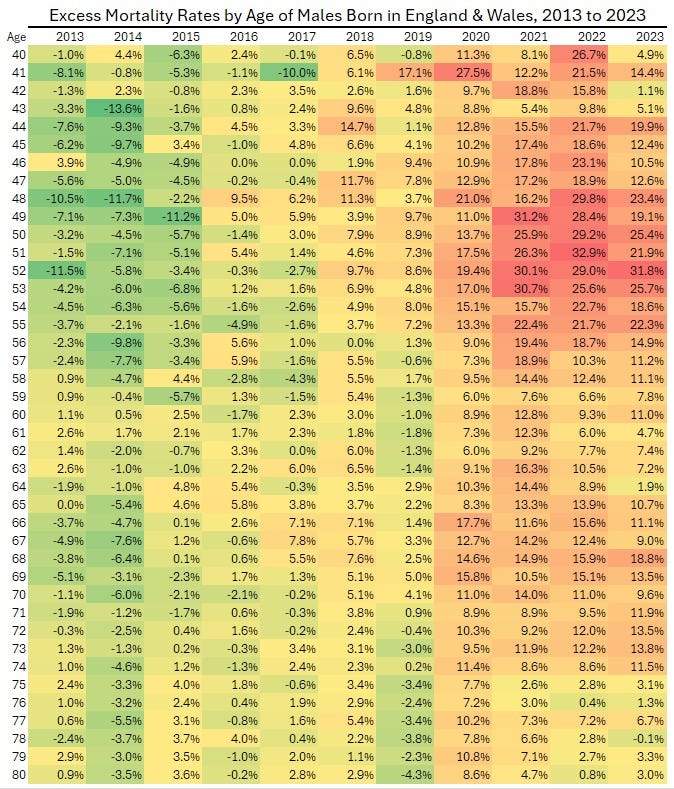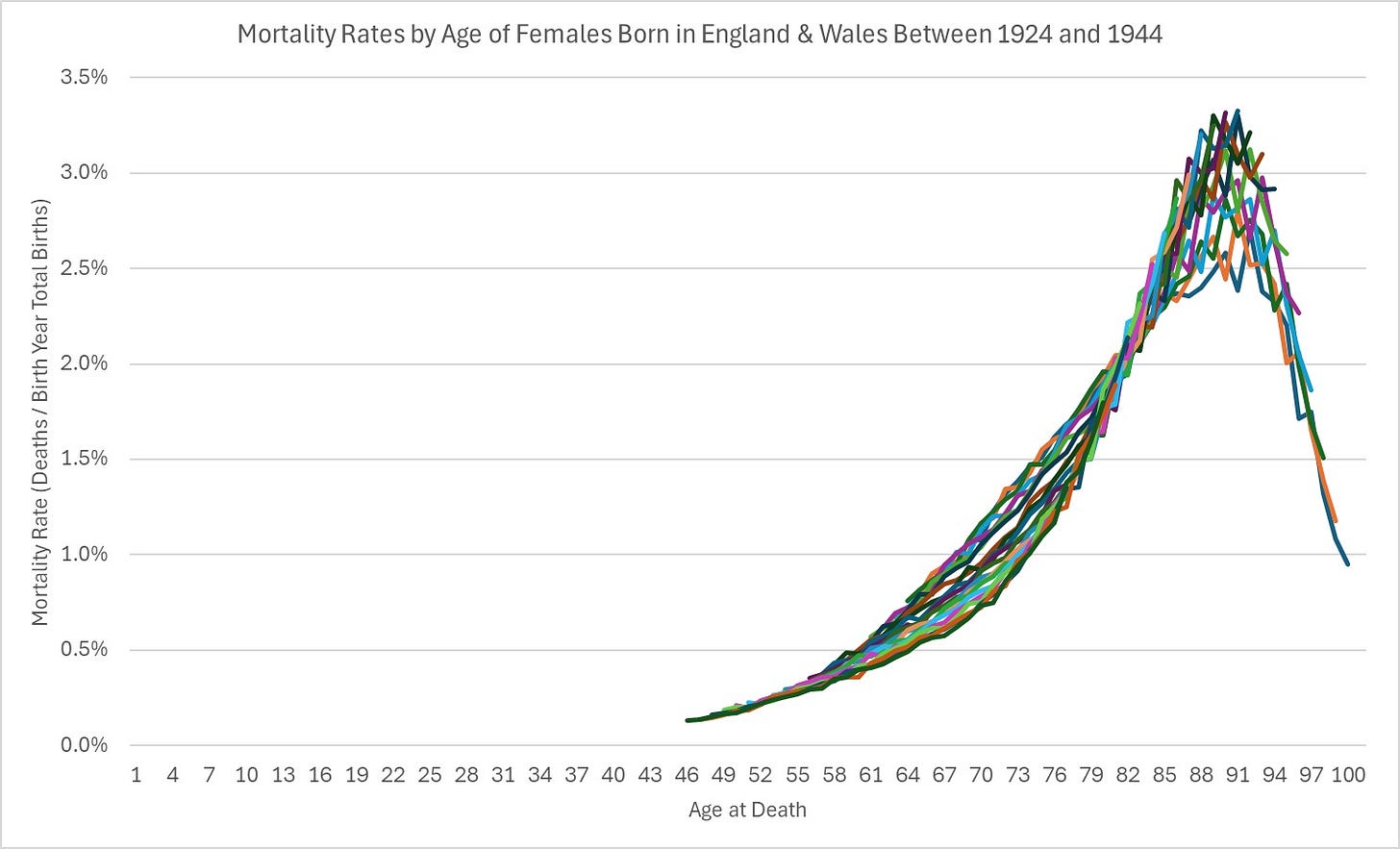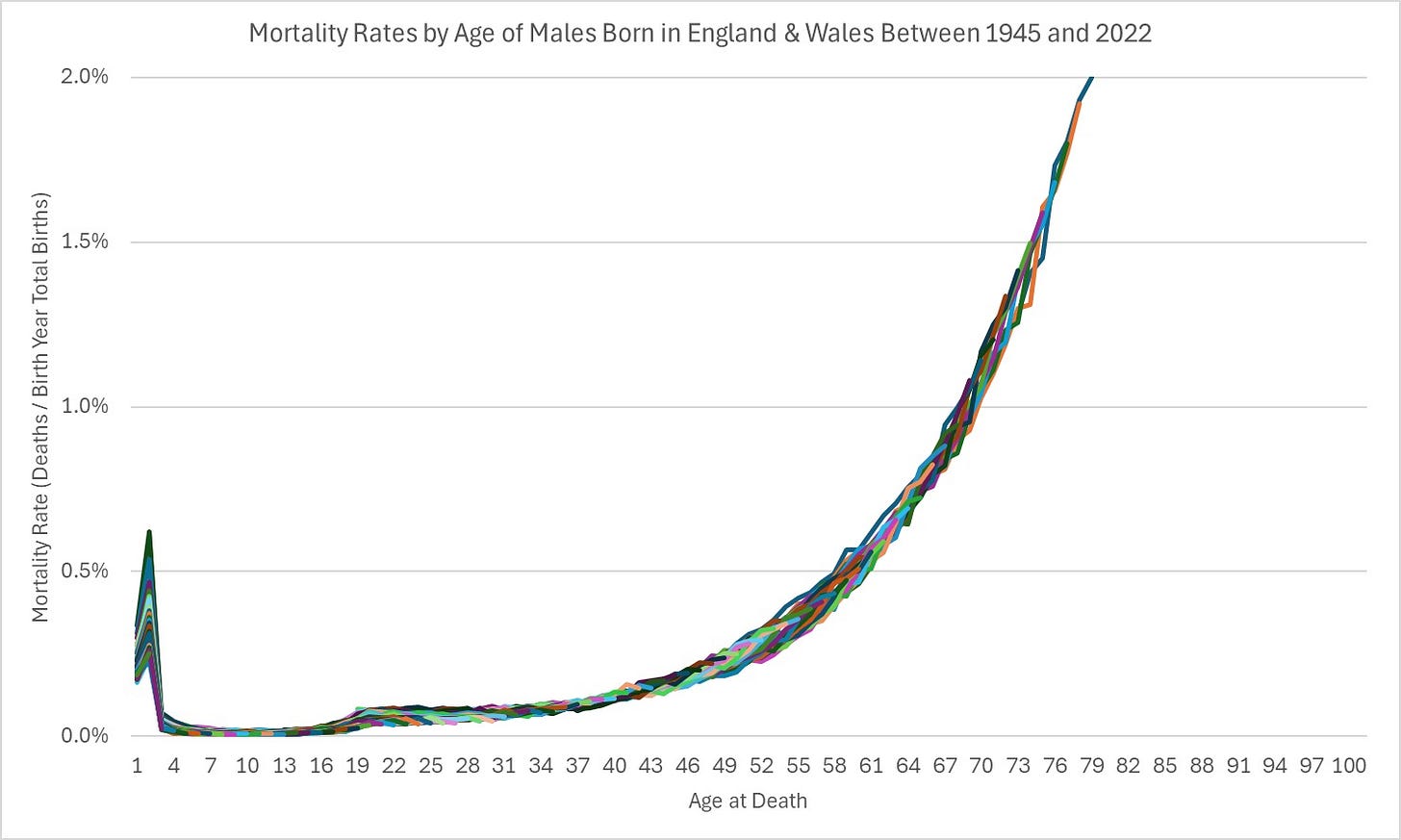Introduction to Excess Mortality Analysis, England & Wales, 2013 to 2023
The young may have been more adversely affected than the old during the "pandemic" years, especially in the post-jab era.
I am preparing another Gompertz mortality analysis. As a precursor, I use a simple model to infer expected mortality rates for future ages, which I can include in the Gompertz model calibration for more robustness.
I made a couple of observations on this simple model that I think are worth sharing1. Accordingly, for both men and women, it appears that the younger ages were more adversely affected in terms of relative excess than the older ages.
Moreover, it seems that the relative excess is worse across all ages under 75 in years 2021 and 2022. It goes without saying that these are more the “COVID jab” years than the “COVID” years, whatever your position on the virus.
I also noticed that there is very apparent improvement in mortality outcomes for those born between 1924 and 1944:
I haven’t labelled all the birth cohorts on the charts above because there are too many but suffice to say that the progression is a shift of people dying in their 50s to 80s, to dying in their 80s and 90s, over the course of 1924 to 1944.
Conversely, apart from the under two year-olds, there is very little evidence of any improvement in mortality outcomes since the Second World War:
I am surprised that what ought to be a very complex situation, ostensibly improved by 80 years of advances in nutritional and health knowledge, and medical treatments should result in an abject lack of improvement in mortality outcomes.
My more learned scientific colleagues are also somewhat baffled, given the alleged successes in treating diseases like cancer and heart disease, that there should be more of a status quo of mortality outcomes.
The cynic in me suggested that perhaps it’s simply because the advances in treatment have simply kept pace with the increases in these diseases? I wonder if anyone is looking at the relationship between the increases and the treatments?!
Notably, the “vaccine” industry went into full throttle immediately after the war. Is it inconceivable, especially with everything else we now know about these products, that they have contributed to the the increase in chronic, and often fatal conditions?
Also, worthy of note is the onslaught against healthy diets of animal proteins and saturated fats in favour of low-fat “healthy” options, saturated in seed oils? Combined with the introduction of statins to inappropriately deal with healthy cholesterol, instead of tackling the glycation of it, might these also be contributing factors?
A short note on the model… I normalised deaths by birth cohort and year, running from July to June, by dividing them by the total births of that cohort. I then modelled each age distribution by fitting a 2-order polynomial, since that was the best, consistent fit for all the data up to 2019. I did not include anything from 2020 onwards in the calibration for obvious reasons.
The obvious limitation of this crude model is the suitability of a simple, 2-order polynomial for the fitting. Indeed, for the ages under 40, the series were actually concave, which is not intuitive, so I did not include them in the final analysis.
In the full model, these younger age projections will not be used as the older age ones are what are required to assist in the Gompertz modelling, where the majority of the deaths and the key inflection between the two overlapping distributions occur. Moreover, any anomalies in the older age projections should also be ironed out if they are too inconsistent with the empirical data points.
On a final note, I do not profess to be an ‘expert’ or ‘authority’ on any of these issues. I am simply sharing my interpretation of quite a lot of recent research on the matters, combined with my insights drawn from the data analysis. I welcome comments from those who know better as I am always keen to build my knowledge scaffold.
The observations are consistent with previous analyses:
When Will You Die?
Here, I briefly present the interim results of my continued research into mortality and longevity risk. I have refined my Gompertz model, using a logarithmic model of empirical death-age data, to help calibrate the model with otherwise sparse input data.













Well, my two ha'pethworth in answer to your questions
Yes and Yes
Thanks Joel, it's an interesting read. Good food for thought.
I would like to see the mortality rates of MUCH younger people. It is obvious - at least in the US - they are much less healthy, on the average, than several decades ago, when I grew up. Yet the invisible elephant in the room led by the emperor in the imaginary finery continues to trample all over them. It is clearly unsustainable, and possibly intended to be.